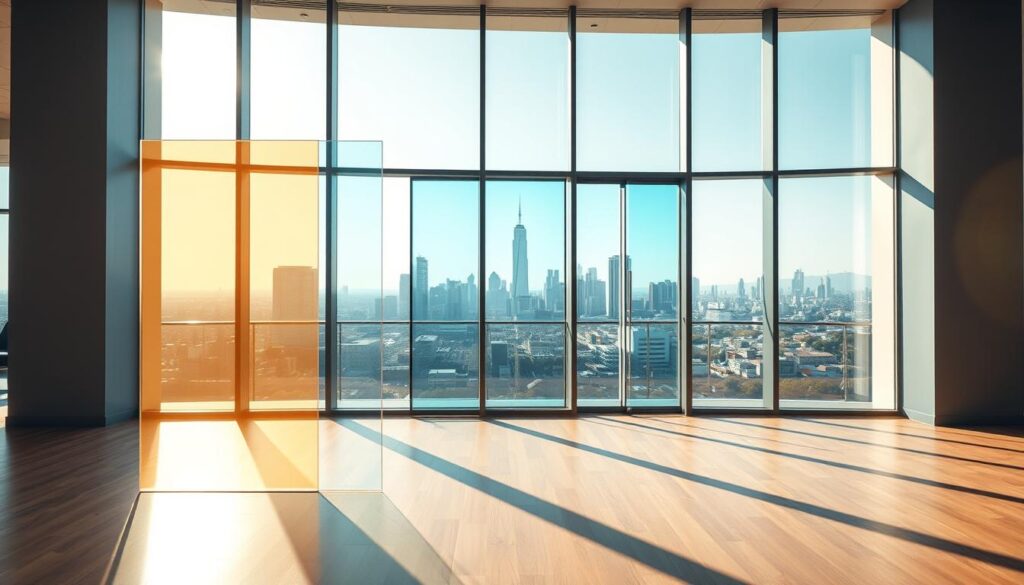Can natural light and UV protection coexist in harmony? As we strive to create buildings that are not only energy-efficient but also healthy for occupants, this question becomes increasingly important.
Natural light is known to enhance ambience, improve mood, and boost energy efficiency. However, with global warming on the rise, the impact of ultraviolet rays (UV) on our buildings and health cannot be ignored. UV-protected glasses play a crucial role in minimizing the harmful effects of UV radiation while illuminating our spaces with natural light.
The right glazing solutions can make all the difference. By balancing natural light with UV protection, we can create healthier and more sustainable buildings.
Key Takeaways
- Natural light improves ambience and mood.
- UV radiation can have harmful effects on buildings and health.
- UV-protective glazing solutions minimize UV radiation.
- Balancing natural light and UV protection is crucial.
- Glazing solutions can create healthier and more sustainable buildings.
What Are UV-Protective Glazing Solutions?
UV-protective glazing is a cutting-edge technology designed to filter out harmful ultraviolet rays while allowing natural light to pass through. This innovative solution is crucial in protecting interiors from the damaging effects of UV radiation.
Definition and Overview
UV-protective glazing solutions are designed to absorb or reflect the sun’s ultraviolet rays, preventing them from entering a building or vehicle. These solutions are integral in maintaining the integrity and longevity of interior furnishings and finishes by reducing fading and degradation caused by UV exposure.
The technology behind UV-protective glazing involves specialized materials and coatings that are applied to windows and other glazing elements. These materials can be in the form of UV-resistant window films or sun-blocking glass coatings that are engineered to provide high levels of UV protection without compromising visibility or aesthetic appeal.
Types of UV-Protective Glazing
There are several types of UV-protective glazing solutions available, catering to different needs and applications. Some of the most common types include:
- UV-resistant window films: These are adhesive films applied to existing windows to provide UV protection.
- Sun-blocking glass coatings: Specialized coatings applied to glass surfaces to filter out UV radiation.
- Integrated UV-protective glazing units: Double or triple-glazed units with built-in UV protection.
| Type of Glazing | UV Protection Level | Application |
|---|---|---|
| UV-resistant window film | Up to 99% | Retrofitting existing windows |
| Sun-blocking glass coatings | Up to 95% | New constructions or window replacement |
| Integrated UV-protective glazing units | Up to 99.9% | High-end constructions or specialized applications |
By understanding the different types of UV-protective glazing solutions, individuals and businesses can make informed decisions about their UV protection needs, ensuring that their interiors remain vibrant and undamaged over time.
Importance of UV Protection in Buildings
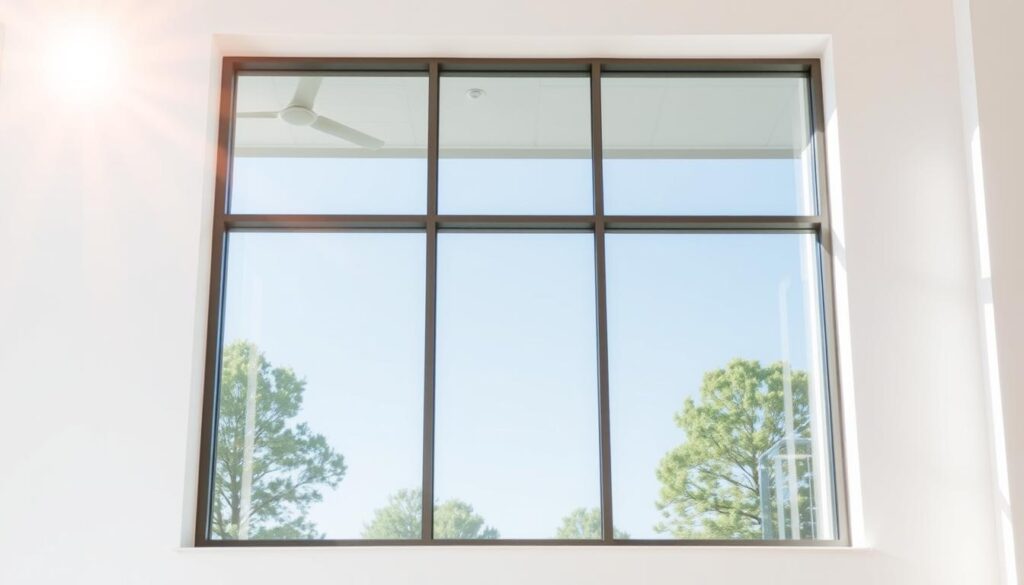
UV protection is crucial in modern building design, safeguarding both the occupants and the interior furnishings from the harmful effects of UV radiation. Prolonged exposure to UV sun radiation can lead to premature ageing, skin damage, and an increased risk of skin cancer. Moreover, ordinary glass cannot prevent UV rays from penetrating the insides of homes and commercial spaces, underscoring the need for protective UV window film and enhanced UV-protection for windows.
Harmful Effects of UV Radiation
UV radiation is known to cause a range of harmful effects on both human health and the longevity of interior furnishings. Some of the key issues include:
- Fading and degradation of furniture and flooring
- Premature ageing and skin damage
- Increased risk of skin cancer
- Deterioration of artworks and other valuable items
For more detailed information on the advantages of UV-protected glass, you can visit this resource, which provides insights into how UV protection can enhance the durability and aesthetic appeal of modern living spaces.
Benefits of UV-Resistant Interiors
Implementing UV protection measures can significantly enhance the durability and aesthetic appeal of building interiors. Some benefits include:
- Prolonged lifespan of interior furnishings
- Reduced risk of health issues related to UV exposure
- Preservation of the original color and quality of interior elements
- Enhanced overall comfort and safety for occupants
By incorporating protective UV window film and other UV-protection technologies, building owners can create healthier, more sustainable, and visually appealing environments. This not only contributes to the well-being of occupants but also adds value to the property by maintaining its aesthetic and functional integrity over time.
How UV-Protective Glazing Works
By incorporating advanced materials and coatings, UV-protective glazing provides a robust defense against UV radiation. This technology is crucial for safeguarding the integrity of interior furnishings and enhancing the comfort and safety of building occupants.
Mechanisms of UV Filtration
UV-protective glazing works by employing various mechanisms to filter out UV rays. These mechanisms involve:
- Absorption: Some UV-protective glazings are designed to absorb UV radiation, converting it into heat that is then dissipated.
- Reflection: Other types of glazings use reflective coatings to bounce UV rays away from the building.
This dual approach ensures that UV-protective glazing can be tailored to meet the specific needs of different buildings and applications.
Types of Coatings and Treatments
Various coatings and treatments can be applied to glazing to enhance its UV-protective capabilities. These include:
- Anti-UV window treatments: Special coatings that can be applied to windows to block UV radiation.
- Low-E coatings: While primarily designed to reduce heat transfer, some Low-E coatings also offer UV protection.
- Specialized films: Thin, adhesive films that can be applied to existing glazing to enhance its UV-protective properties.
The selection of the appropriate coating or treatment depends on factors such as the building’s location, the orientation of the glazing, and the desired level of UV protection.
Applications of UV-Protective Glazing
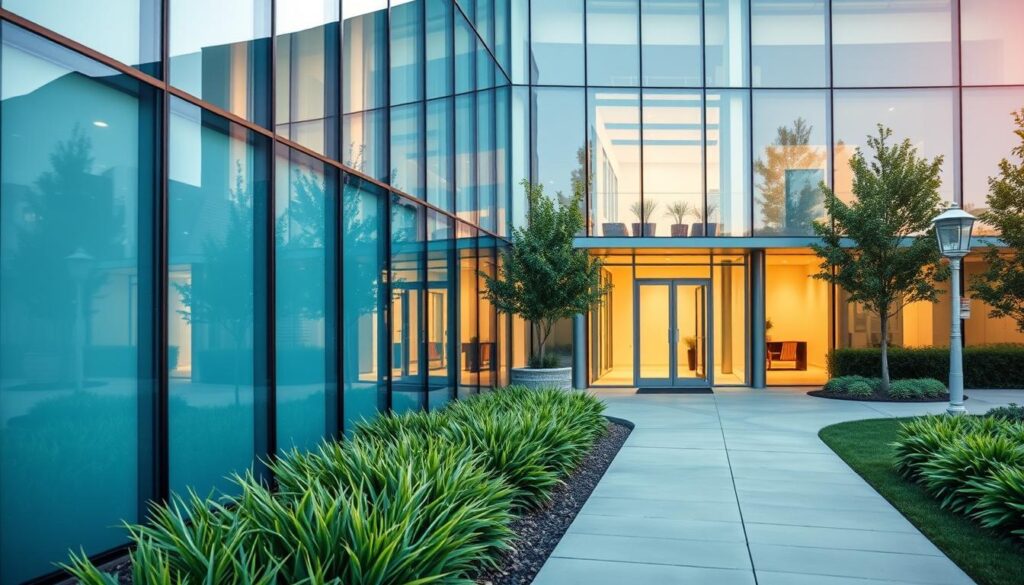
The applications of UV-protective glazing are diverse, ranging from residential homes to commercial buildings and vehicles. This versatility is a testament to the technology’s ability to provide UV protection and energy efficiency across different sectors.
Residential Use
In residential settings, UV-protective glazing is used to safeguard interiors from the harmful effects of UV radiation. This not only preserves the color and integrity of furnishings but also enhances the comfort of living spaces by reducing heat gain. Homeowners can benefit from high-performance UV-blocking windows that minimize the fading of carpets, furniture, and artwork.
“The right glazing solution can significantly reduce the need for interior shading devices, thus maximizing natural light while protecting against UV damage.”
Commercial Use
Commercial buildings also benefit significantly from UV-protective glazing. Offices, retail spaces, and museums use advanced UV control solutions to protect valuable assets and create comfortable environments for occupants. By reducing UV exposure, businesses can lower maintenance costs associated with replacing faded materials and improve energy efficiency.
Automotive Applications
The automotive industry has adopted UV-protective glazing to enhance the driving experience and protect vehicle interiors. Modern vehicles often feature UV-blocking windscreens and side windows that reduce the risk of UV damage to both occupants and interior components. This technology contributes to a more comfortable driving experience by minimizing heat buildup inside the vehicle.
- Reduces UV exposure to drivers and passengers
- Protects interior materials from fading and damage
- Enhances overall comfort by reducing heat gain
Key Benefits of UV-Protective Glazing
The incorporation of UV-protective glazing in buildings significantly enhances occupant safety and comfort while reducing energy consumption. This is achieved through advanced technologies that filter out harmful UV radiation, thereby protecting both occupants and interior furnishings.
Enhanced Safety and Comfort
UV-protective glazing solutions play a crucial role in creating a safer and more comfortable indoor environment. By reducing glare and preventing UV-related health issues, these glazing solutions contribute to the well-being of building occupants. For instance, a study by the American Architectural Manufacturers Association highlights the importance of UV protection in glazing.
Key benefits include:
- Reduced risk of UV-related health issues
- Minimized glare for improved visual comfort
- Protection of interior furnishings from UV damage
Energy Efficiency
In addition to enhancing safety and comfort, UV-protective glazing also improves energy efficiency. By minimizing heat gain in the summer and heat loss in the winter, these glazing solutions can significantly reduce the energy required for heating and cooling. According to the
“U.S. Department of Energy, energy-efficient windows can save homeowners between $125 and $465 annually.”
| Energy Efficiency Benefits | Description | Impact |
|---|---|---|
| Reduced Heat Gain | Minimizes the amount of heat entering the building during summer | Lower cooling costs |
| Reduced Heat Loss | Minimizes the amount of heat escaping the building during winter | Lower heating costs |
| Overall Energy Savings | Combination of reduced heat gain and loss | Significant reduction in energy consumption |
By investing in UV-protective glazing, building owners can enjoy not only enhanced safety and comfort but also significant energy savings, contributing to a more sustainable and cost-effective building operation.
Choosing the Right Glazing Solution
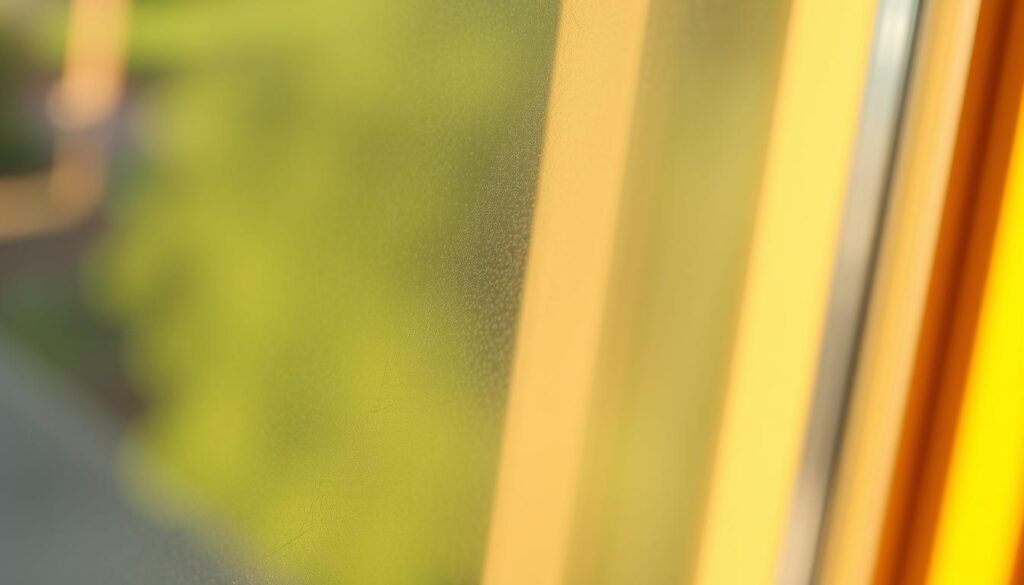
The effectiveness of UV-protective glazing largely depends on selecting the right solution for your specific needs. With various options available, it’s essential to consider several factors to make an informed decision.
Factors to Consider
When choosing a glazing solution, several key factors come into play. These include:
- The type of UV protection needed based on the building’s orientation and location
- The climate and environmental conditions of the area
- The building’s design and architectural style
- The desired level of energy efficiency and sustainability
For instance, a building in a sunny climate may require a more advanced UV-resistant window film to provide adequate protection against UV radiation. It’s also important to consider the compatibility of the glazing solution with the existing window frames and the overall aesthetic appeal.
Expert Recommendations
Seeking expert advice can significantly simplify the process of choosing the right glazing solution. Professionals can provide valuable insights based on their experience and knowledge of the latest technologies. For a comprehensive guide on selecting the right window glazing, you can refer to resources like this guide.
Some key recommendations from experts include:
- Assessing the specific UV protection needs of your building
- Evaluating the energy efficiency of different glazing options
- Considering the long-term durability and maintenance requirements
By carefully considering these factors and seeking expert recommendations, you can make an informed decision that meets your needs and enhances the overall performance of your windows.
The Role of UV-Protective Glazing in Sustainability
UV-protective glazing contributes to the sustainability of buildings by reducing energy consumption and protecting interior furnishings. This dual benefit is achieved through the use of protective UV window film, which filters out harmful ultraviolet radiation while allowing visible light to pass through.
Reducing Energy Consumption
One of the primary ways UV-protective glazing enhances sustainability is by reducing the need for artificial lighting and cooling systems. By allowing natural light to illuminate interior spaces, the demand for electric lighting decreases, leading to lower energy consumption. Additionally, by minimizing the heat gain from UV radiation, buildings require less cooling, further reducing energy usage.
| Benefits | Description | Impact on Sustainability |
|---|---|---|
| Reduced Artificial Lighting | Natural light illumination reduces the need for electric lighting. | Lowers energy consumption |
| Minimized Heat Gain | UV-protective glazing reduces heat gain from UV radiation. | Decreases cooling requirements |
| Energy Efficiency | Overall reduction in energy consumption through natural lighting and reduced cooling needs. | Enhances sustainability |
Longevity of Interior Furnishings
UV-protective glazing also plays a crucial role in prolonging the lifespan of interior furnishings. By blocking harmful UV rays, it prevents the fading and degradation of materials such as fabrics, wood, and plastics. This not only reduces the need for frequent replacements but also maintains the aesthetic appeal of interior spaces over time.
By incorporating UV-protective glazing, building owners can achieve significant long-term savings and contribute to a more sustainable built environment. The use of protective UV window film is a simple yet effective strategy for enhancing the sustainability of buildings.
Innovations in UV-Protective Glazing Technology
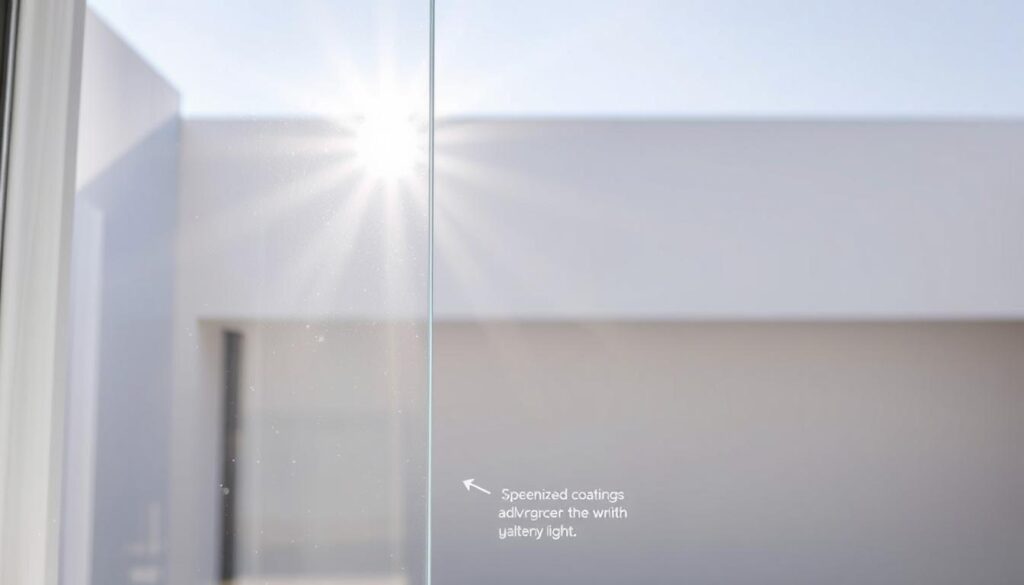
Advancements in coating technologies and smart glazing solutions are enhancing the performance of UV-protective glazing. These innovations are not only improving UV protection but also contributing to energy efficiency, making buildings more sustainable.
Advanced Coating Technologies
Recent developments in coating technologies have significantly enhanced the capabilities of UV-protective glazing. Advanced coatings can now filter out a higher percentage of UV radiation, reducing the harmful effects on interiors. These coatings are designed to be durable and long-lasting, ensuring that the glazing remains effective over its lifespan.
The application of nanotechnology in coating development has opened new avenues for UV protection. Nanocoatings can be tailored to provide specific levels of UV filtration, visible light transmission, and solar heat gain coefficient, offering a high degree of customization for different architectural needs.
| Coating Technology | UV Filtration Efficiency | Visible Light Transmission |
|---|---|---|
| Standard Coating | 80% | 70% |
| Advanced Nanocoating | 95% | 85% |
| Smart Coating | 90% | 80% |
Smart Glazing Solutions
Smart glazing solutions represent a significant leap forward in UV-protective technology. These solutions incorporate electrochromic or thermochromic materials that can change their tint in response to environmental conditions, optimizing UV protection and energy efficiency.
Electrochromic glazing, for instance, can adjust its tint based on the intensity of sunlight, reducing the need for artificial lighting and minimizing heat gain during peak sun hours. This technology not only enhances comfort but also reduces energy consumption, contributing to a more sustainable building envelope.
The integration of smart glazing solutions with building management systems (BMS) allows for real-time monitoring and control, further optimizing energy use and UV protection. As the technology continues to evolve, we can expect even more sophisticated smart glazing solutions that will redefine the standards for UV-protective glazing.
Installation Process of UV-Protective Glazing
Effective installation of UV-protective glazing is crucial for enhancing the safety and comfort of buildings. Proper installation ensures that the glazing performs optimally, providing maximum protection against harmful UV radiation.
Pre-Installation Considerations
Before installing UV-protective glazing, several factors must be considered to ensure a successful installation. These include assessing the building’s orientation, window size, and the type of framing used.
- Assess the building’s orientation to determine the level of UV exposure.
- Measure the window size accurately to ensure a proper fit.
- Choose the appropriate framing material that complements the glazing.
Steps for Effective Installation
The installation process involves several key steps. First, the old glazing or window is removed, and the area is prepared for the new UV-protective glazing.
- Remove the existing glazing or window carefully to avoid damage.
- Inspect and clean the frame to ensure a smooth installation.
- Install the new UV-protective glazing, ensuring it is securely fastened.
Table: Comparison of Installation Steps for Different Types of UV-Protective Glazing
| Installation Step | Glass Glazing | Plastic Glazing |
|---|---|---|
| Removal of Old Glazing | Careful handling to avoid breakage | Simple removal with minimal risk |
| Frame Preparation | Cleaning and inspecting for damage | Checking for any warping or damage |
| Installation of New Glazing | Secure fastening to prevent leakage | Ensuring a snug fit to prevent gaps |
Post-Installation Maintenance
After installation, regular maintenance is necessary to ensure the longevity and effectiveness of the UV-protective glazing. This includes cleaning the glazing regularly and inspecting for any signs of damage.
By following these guidelines, building owners can enjoy the benefits of UV-protective glazing for years to come. Regular maintenance not only extends the lifespan of the glazing but also ensures that it continues to provide optimal UV protection.
Cost Considerations for UV-Protective Glazing
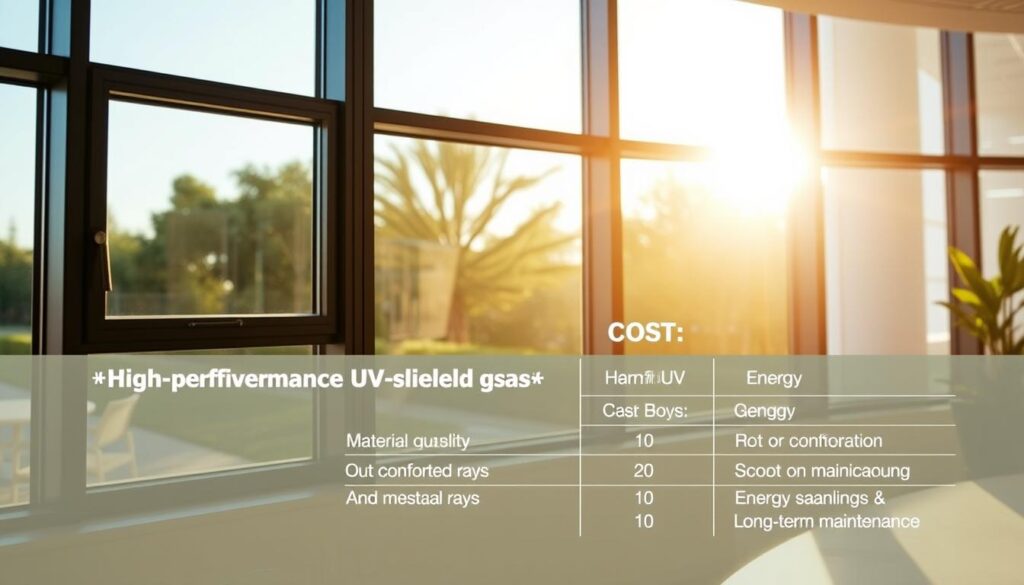
Assessing the cost of UV-protective glazing involves evaluating both the initial investment and the long-term benefits. While the upfront cost may be higher than traditional glazing solutions, the long-term savings and benefits can significantly outweigh the initial expense.
Initial Investment vs. Long-Term Savings
The initial investment in UV-protective glazing is often higher due to the advanced technology and materials used. However, this investment can lead to substantial long-term savings through reduced energy consumption and extended lifespan of interior furnishings. For instance, UV-protective window tinting can reduce the need for frequent replacements and maintenance.
Long-term savings can be achieved through:
- Reduced energy consumption due to improved thermal regulation
- Extended lifespan of interior furnishings by protecting them from UV damage
- Lower maintenance costs as UV-protective glazing is often more durable
ROI in Residential vs. Commercial Settings
The return on investment (ROI) for UV-protective glazing varies between residential and commercial settings. In residential settings, homeowners can benefit from energy savings and reduced maintenance costs. In commercial settings, businesses can enjoy not only energy savings but also enhanced comfort and productivity for employees, potentially leading to increased profitability.
| Setting | ROI Factors | Potential Savings |
|---|---|---|
| Residential | Energy savings, reduced maintenance | Up to 30% on energy bills |
| Commercial | Energy savings, enhanced employee comfort and productivity | Up to 20% on energy bills, potential increase in productivity |
By understanding the cost considerations and potential ROI, individuals and businesses can make informed decisions about investing in UV-protective glazing solutions. High-performance UV-blocking windows offer a valuable opportunity for long-term savings and enhanced property value.
Regulations and Standards for UV-Protective Glazing
Understanding the regulations and standards for UV-protective glazing is crucial for ensuring the safety and effectiveness of glazing solutions. As the demand for advanced UV control solutions grows, adherence to these regulations becomes increasingly important.
The regulations governing UV-protective glazing are multifaceted, involving both building codes and industry standards. Building codes are critical as they dictate the minimum requirements for glazing solutions in various types of buildings, ensuring safety and compliance.
Building Codes and Compliance
Building codes vary significantly by region, reflecting local climate conditions, architectural styles, and safety standards. For UV-protective glazing, these codes often specify:
- The level of UV protection required
- The types of glazing materials allowed
- Installation practices to ensure durability and performance
Compliance with these codes is not only mandatory but also beneficial, as it ensures that the glazing solutions provide the intended level of protection and performance.
Industry Standards
Industry standards for UV-protective glazing are developed by various organizations and cover aspects such as:
- Performance criteria for UV protection
- Testing methods to verify compliance
- Certification processes for manufacturers
Adhering to these standards is essential for manufacturers to ensure their products meet the required safety and performance thresholds. For consumers, choosing products that comply with industry standards is crucial for obtaining effective UV-protective glazing solutions.
By understanding and adhering to the regulations and standards for UV-protective glazing, stakeholders can ensure the implementation of advanced UV control solutions that enhance safety, comfort, and energy efficiency in buildings.
Comparing UV-Protective Glazing Options
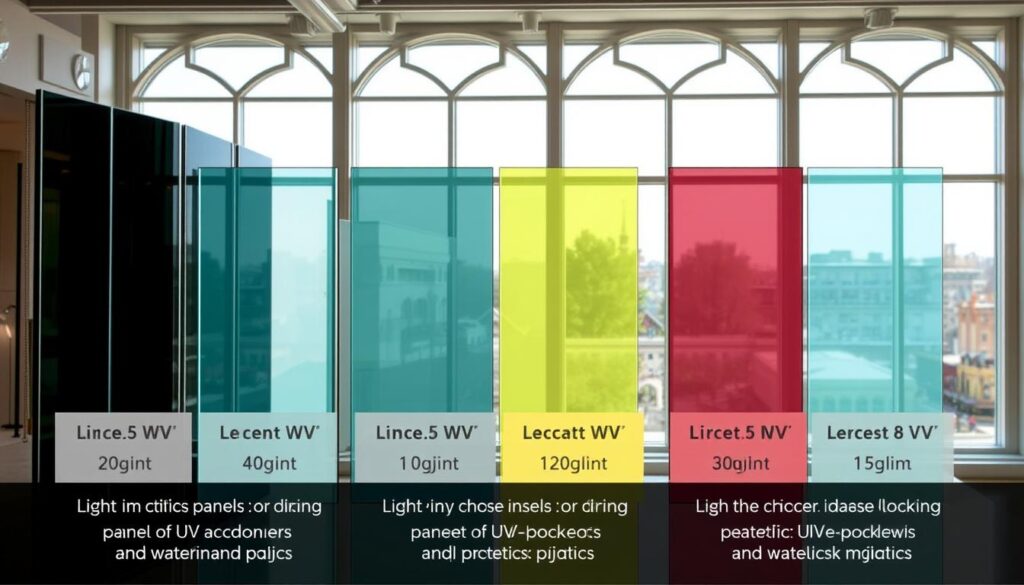
Understanding the differences between UV-protective glazing options is key to making an informed decision. With various materials and designs available, each with its own set of advantages and considerations, comparing these options is essential.
Glass vs. Plastic Glazing
The debate between glass and plastic glazing continues, with each having its proponents. Glass glazing is often praised for its durability and aesthetic appeal. It provides excellent UV protection and can be treated with various coatings to enhance its performance. On the other hand, plastic glazing is lighter and more impact-resistant, making it a viable option for certain applications.
When choosing between glass and plastic, consider the specific needs of your project. For instance, if you’re looking for a more sustainable option, you might want to explore UV-protective glazing solutions that offer both UV protection and energy efficiency.
Performance vs. Aesthetics
The choice between performance and aesthetics is a crucial one. While performance is critical for UV protection and energy efficiency, aesthetics play a significant role in the overall design and appeal of a building or artwork. Striking a balance between the two is essential.
“The best UV-protective glazing solutions are those that seamlessly integrate performance and aesthetics, providing both functionality and visual appeal.”
To achieve this balance, consider the following factors:
- The level of UV protection required
- The desired aesthetic outcome
- The budget for the project
- The long-term maintenance and durability needs
By weighing these factors, you can make an informed decision that meets both your performance and aesthetic needs.
Maintenance of UV-Protective Glazing Solutions
Maintaining UV-protective glazing solutions is crucial for their effectiveness and longevity. Regular maintenance ensures that these glazing solutions continue to provide optimal UV protection and maintain their aesthetic appeal.
Cleaning and Care Tips
Proper cleaning is essential to maintain the integrity of UV-protective glazing. Use a mild detergent and water solution to clean the glazing. Avoid using abrasive materials or harsh chemicals, as they can damage the UV-protective coating.
Recommended Cleaning Practices:
- Use a soft, lint-free cloth or sponge.
- Avoid using paper towels, which can scratch the surface.
- Clean the glazing regularly to prevent dirt buildup.
- Rinse thoroughly with clean water to remove any soap residue.
For more stubborn stains or dirt buildup, a mixture of vinegar and water can be effective. However, it’s essential to test any new cleaning solution on a small, inconspicuous area first to ensure it doesn’t damage the glazing.
Common Issues and Troubleshooting
Despite proper maintenance, some issues may arise with UV-protective glazing. Here are some common problems and their potential solutions:
| Issue | Cause | Solution |
|---|---|---|
| Discoloration | Exposure to harsh chemicals or extreme temperatures | Replace the affected glazing; ensure proper cleaning practices. |
| Bubbling or Delamination | Poor installation or manufacturing defects | Consult a professional for repair or replacement. |
| Scratches | Abrasive materials or accidental damage | Use a scratch repair kit; avoid using abrasive materials. |
Regular inspection and maintenance can help identify and address these issues early on, ensuring the longevity of the UV-protective glazing.
Future Trends in UV-Protective Glazing
The future of UV-protective glazing is poised for significant advancements, driven by ongoing research and development in the field. As technology continues to evolve, we can expect to see new and innovative solutions emerge, potentially leading to improved performance and wider adoption of protective UV window film.
Advancements in Technology
Research into advanced materials and coatings is expected to play a crucial role in shaping the future of UV-protective glazing. New technologies may offer enhanced UV filtration, improved durability, and increased energy efficiency, making UV-protective glazing an even more attractive option for residential and commercial applications.
Market Shifts
As awareness of the benefits of UV-protective glazing grows, we can anticipate prospective market changes. The demand for protective UV window film and other UV-protective glazing solutions is likely to increase, driven by consumer demand for safer, more sustainable building materials. This trend is expected to be particularly pronounced in regions with high levels of UV radiation, where the benefits of UV-protective glazing are most pronounced.
Future trends in UV-protective glazing will be characterized by continued innovation and growing demand, driven by the need for more sustainable and protective building solutions.
